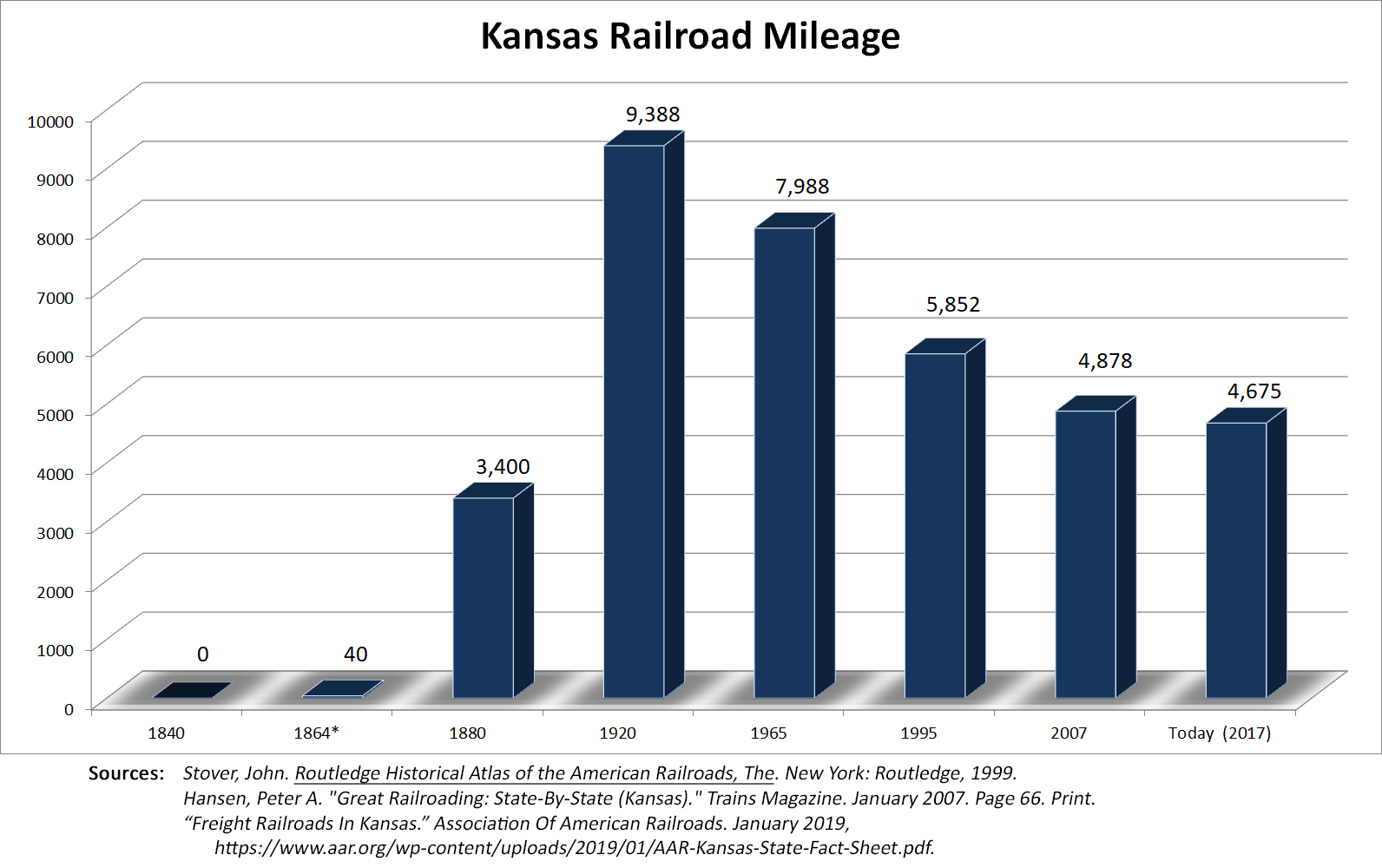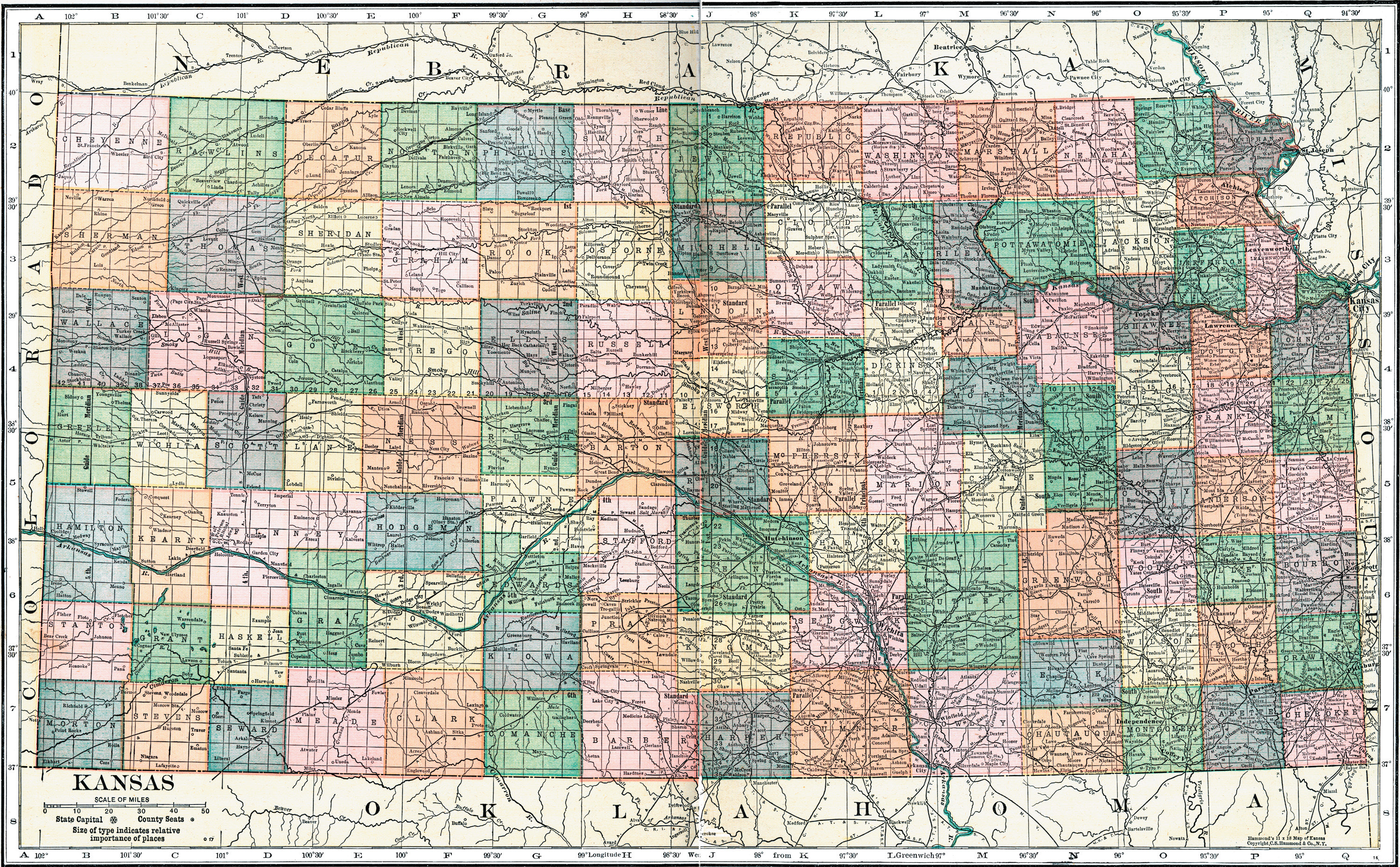- Home ›
- The States ›
- Kansas
Kansas Railroads: State Map, History, Abandoned Lines
Last revised: September 7, 2024
By: Adam Burns
Kansas railroads are extremely rich in history albeit one may not think
or realize it when they see that flat open farm country that defines the
state.
At one time Kansas ranked a whopping third in total rail mileage due to its rich agricultural base as railroads looked to tap all corners of the state to reach these areas (Kansas is regarded as one of the granger states because of its farming importance to railroads).
Beyond farming, Kansas became a battleground of tycoons who attempted to outduel one another for control of railroads in the western United States, most notably Jay Gould and Edward Harriman.
Their efforts led to thousands of miles of redundant tracks in Kansas which surprisingly remained in service well into the mid-20th century.
For these reasons, the state suffered thousands of miles of lines removed after World War II and today you can still see these old grades scarring the landscape.
While Kansas has since slipped in this category and today only carries about half of its all time high (much of this loss has been the abandonment of these agricultural branch lines during the 1970s and 1980s), railroads are still very important in the Sunflower State.
These include Class I systems BNSF Railway, Union Pacific, Kansas City Southern all operating key routes within the state along with a number of regional and short line carriers.
Photos
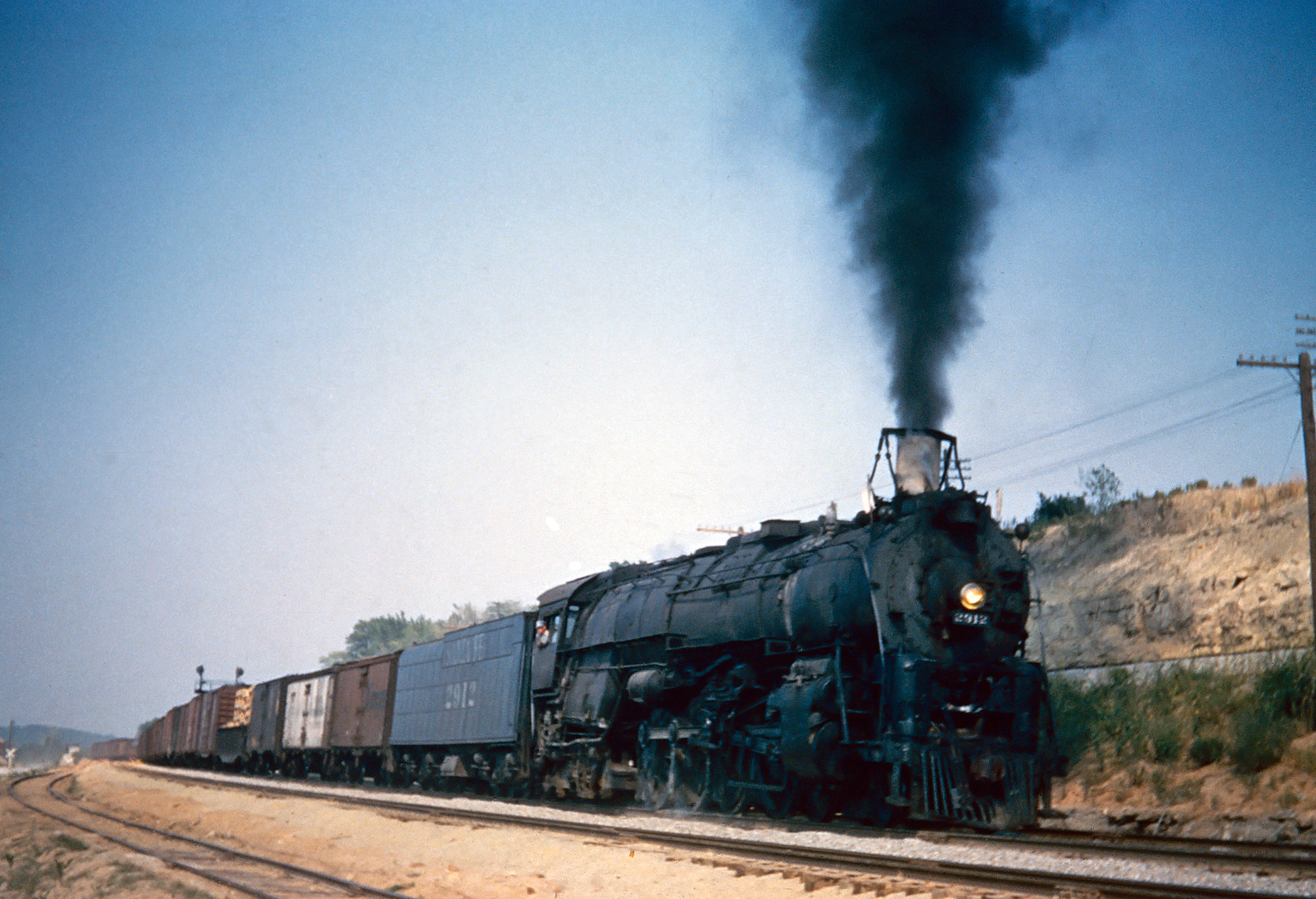 Santa Fe 4-8-4 #2912 leads a general manifest out of Argentine Yard in Argentine, Kansas on August 22, 1953. American-Rails.com collection.
Santa Fe 4-8-4 #2912 leads a general manifest out of Argentine Yard in Argentine, Kansas on August 22, 1953. American-Rails.com collection.History
The state's railroads date back to the Leavenworth, Pawnee & Western, which was chartered in 1855 to connect the Missouri River with Fort Riley.
Construction of the line did not actually begin until 1863 at which point it was organized under the name of the Union Pacific Eastern Division by Congress.
The Union Pacific, of course, came about because of the Pacific Railroad Act of 1862 to build the country's first transcontinental railroad.
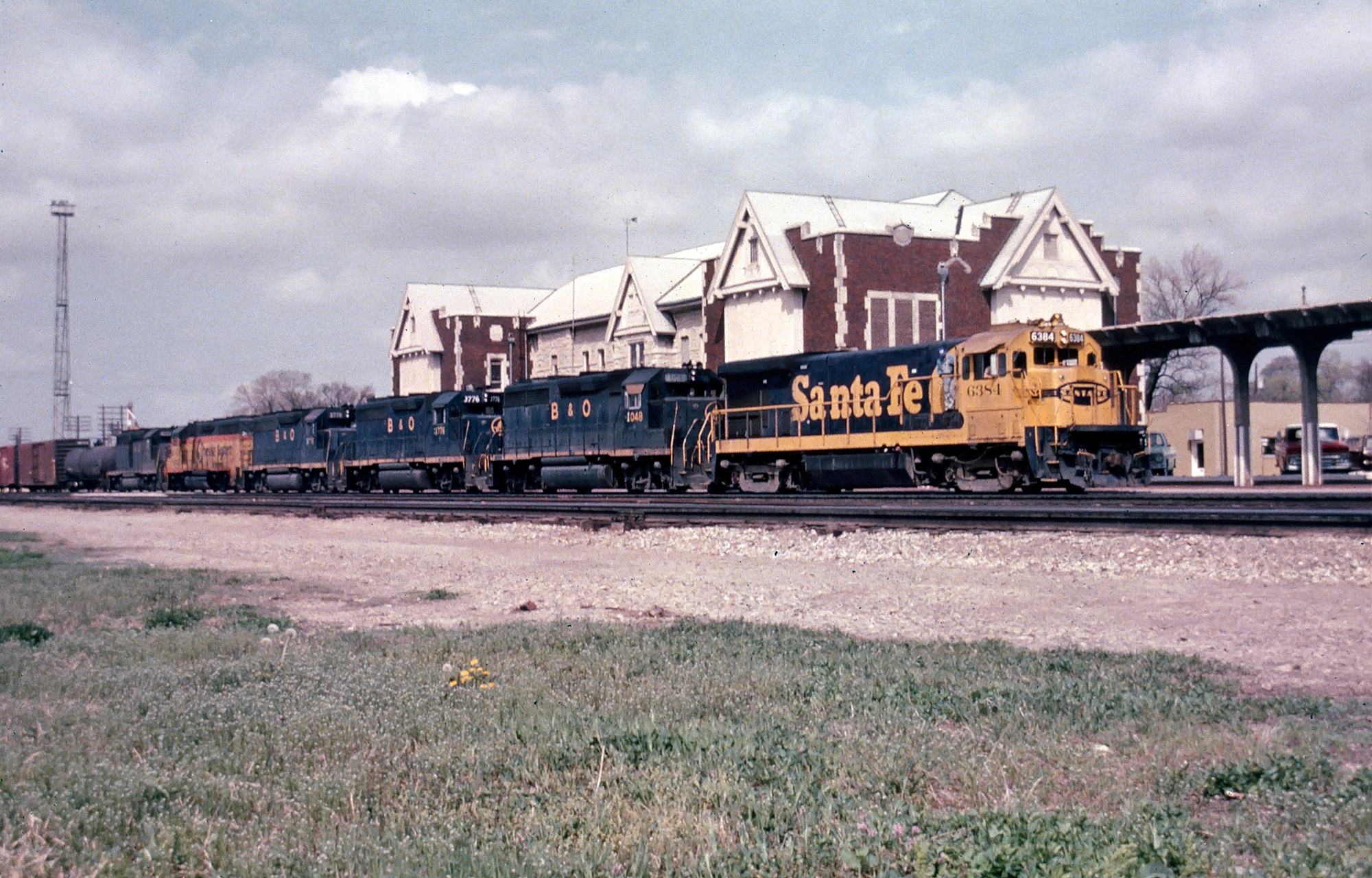 Santa Fe B23-7 #6384, and a group of leased Baltimore & Ohio Geeps, have an eastbound freight at Emporia, Kansas, circa 1980. The historic depot later burned in 1999. Mike Bledsoe photo. American-Rails.com collection.
Santa Fe B23-7 #6384, and a group of leased Baltimore & Ohio Geeps, have an eastbound freight at Emporia, Kansas, circa 1980. The historic depot later burned in 1999. Mike Bledsoe photo. American-Rails.com collection.Abandoned Lines
Kansas is another state which has suffered a tremendous loss to its rail network. Like Iowa, Minnesota, Illinois, Wisconsin, and other Midwestern states, Kansas was blanketed with agricultural branch lines.
It was so thick with railroads the state's peak network approached 10,000 miles. All of the region's major carriers served Kansas although the Santa Fe and Missouri Pacific provided the greatest coverage.
As such, most of the abandoned lines here are of AT&SF and MP heritage. As it turns out, the leadership of these roads, William Barstow Strong (AT&SF) and Jay Gould (MP), began a fierce battle during the latter 19th century for control of the region's agriculture and cattle trade.
Gould, in particular, laid down a web of branch lines for no other reason than to stave off Strong's growing empire. Surprisingly, some of these lines survived far longer than they should have and were still in service into the 1970s-1980s.
In addition to abandoned AT&SF and MP lines, you can also find traces of the St. Louis-San Francisco (Frisco), Missouri-Kansas-Texas (Katy), Rock Island, Chicago Great Western, and Union Pacific.
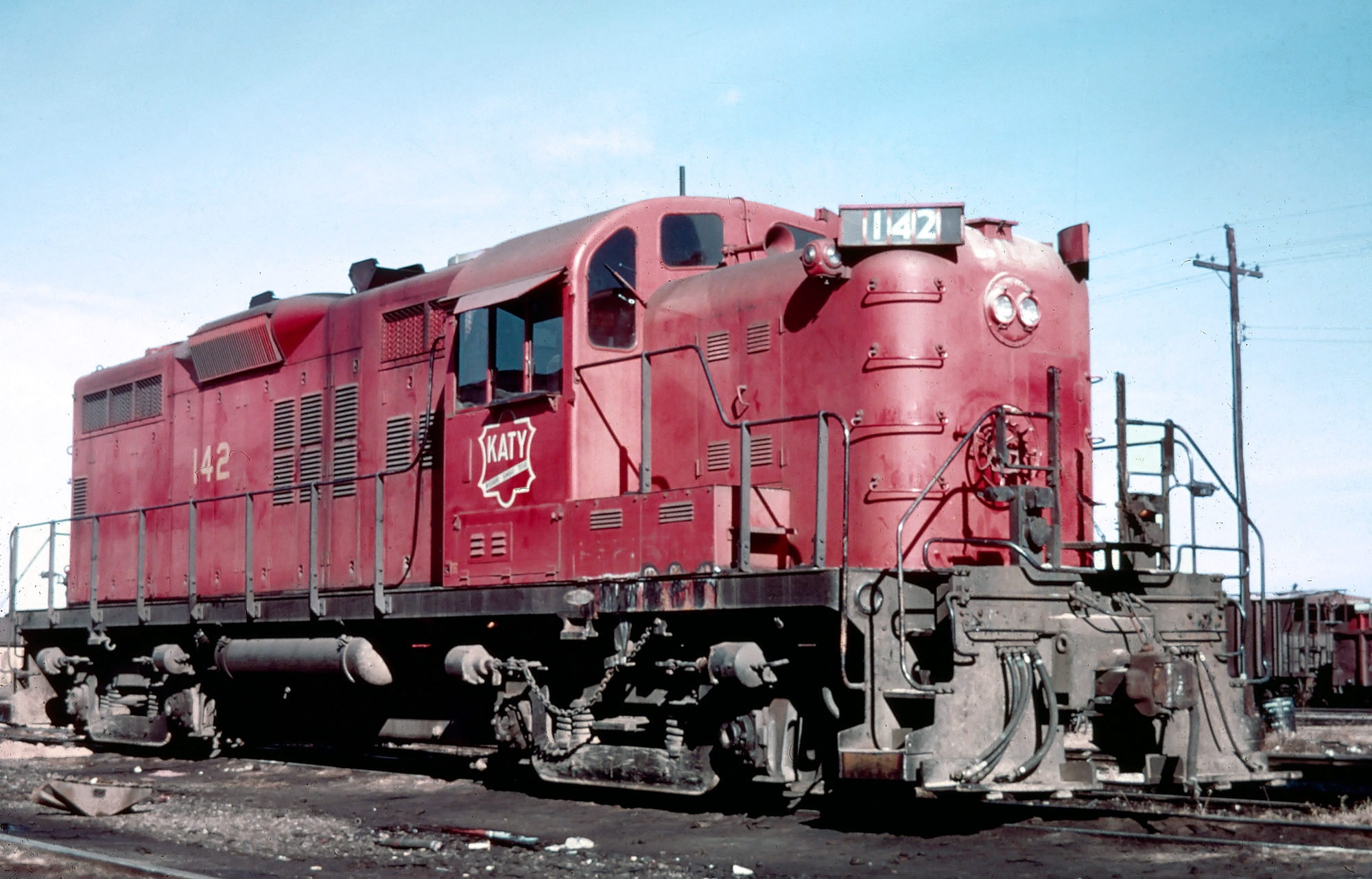 One of Katy's RS3m rebuilds, #142, at Parsons, Kansas, circa 1968. This unit was rebuilt with an EMD 567C in October, 1959, which required a Geep hood to house the engine block. Today, the locomotive operates on the Ottawa Northern Railroad (formerly Midland Railway) in Baldwin City, Kansas. Mac Owen photo. American-Rails.com collection.
One of Katy's RS3m rebuilds, #142, at Parsons, Kansas, circa 1968. This unit was rebuilt with an EMD 567C in October, 1959, which required a Geep hood to house the engine block. Today, the locomotive operates on the Ottawa Northern Railroad (formerly Midland Railway) in Baldwin City, Kansas. Mac Owen photo. American-Rails.com collection.The name was later changed to the Kansas Pacific Railway in 1869 after it had connected Kansas City with Denver, Colorado.
In the following years Kansas would come to have several of our most revered western and granger railroads operating within its borders.
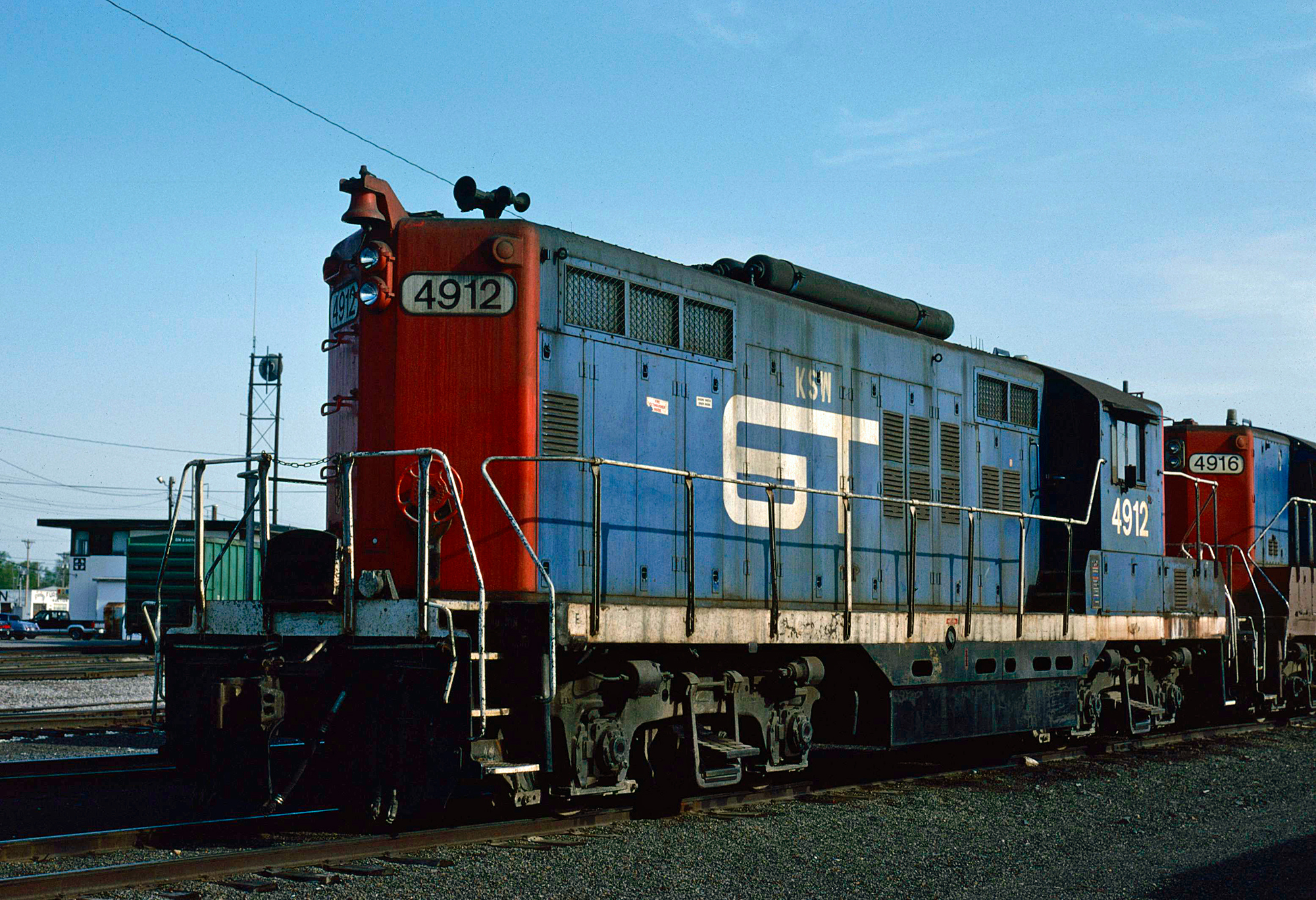 A pair of former Grand Trunk Western GP9's, patched for new owner Kansas Southwestern, layover in Wichita, Kansas on the morning of April 25, 1993. The KSW is now part of the Kansas & Oklahoma (Watco). Jim Shepard photo. American-Rails.com collection.
A pair of former Grand Trunk Western GP9's, patched for new owner Kansas Southwestern, layover in Wichita, Kansas on the morning of April 25, 1993. The KSW is now part of the Kansas & Oklahoma (Watco). Jim Shepard photo. American-Rails.com collection.Current Railroads
- BNSF Railway
- Kansas City Southern
- Union Pacific
- Blackwell Northern Gateway Railroad
- Cimarron Valley Railroad
- Kansas & Oklahoma Railroad
- Kyle Railroad
- Kaw River Railroad
- Missouri & Northern Arkansas
- Nebraska, Kansas & Colorado
- South Kansas & Oklahoma
- Blackwell Northern Gateway Railroad
- Garden City Western Railway
- Kansas City Terminal Railway
- Kaw River Railroad
- V&S Railway
- Wichita Union Terminal Railway
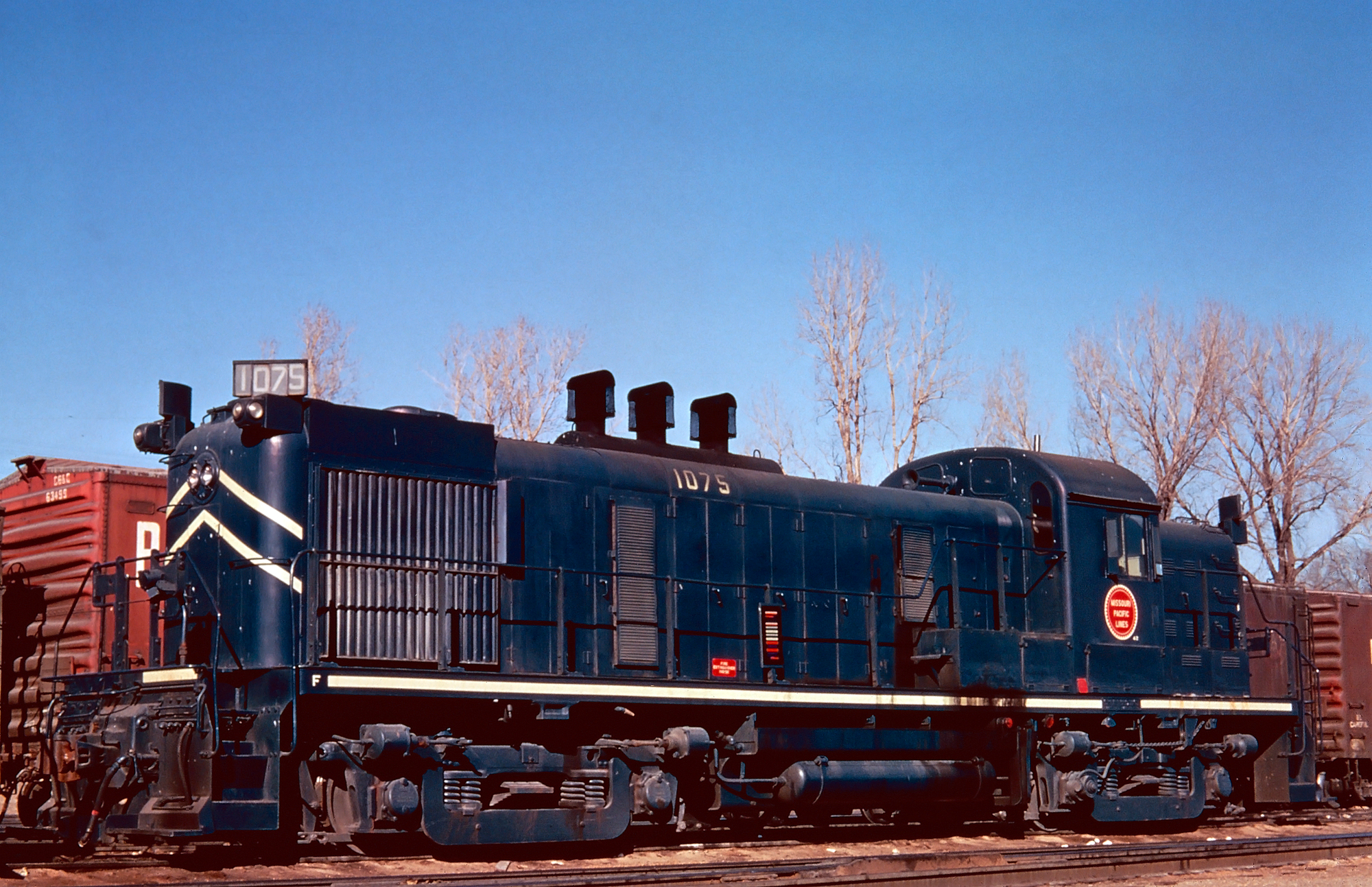 Missouri Pacific RS3m/GP12 #1075 at Coffeyville, Kansas, circa 1969. This was one of several MoPac RS3's rebuilt by the North Little Rock Shops with a 12-cylinder model 567A and reclassified as a "GP12" (sometimes referred to as an RS3m). American-Rails.com collection.
Missouri Pacific RS3m/GP12 #1075 at Coffeyville, Kansas, circa 1969. This was one of several MoPac RS3's rebuilt by the North Little Rock Shops with a 12-cylinder model 567A and reclassified as a "GP12" (sometimes referred to as an RS3m). American-Rails.com collection.As for the state's route mileage, today it totals fewer than 5,000 although at its peak in the 1920s that number pushed 9,400.
At A Glance
Much of this loss was, again, due to the decline in farms shipping their products by rail although it was also caused simply by overbuilding, a similar issue affecting many granger states (there was just too much supply and not enough demand, particularly following World War II).
For a more in-depth look at Kansas, in terms of its rail mileage over the years please refer to the chart above.
State Mileage Chart
First Railroad
* Kansas's first railroad was the Leavenworth, Pawnee & Western Railroad (LP&W), chartered in 1855. At the time the region was virtually devoid of settlement and as a result no funding could be secured for its construction.
However, when the Union Pacific was formed in 1862 to build the eastern component of the Transcontinental Railroad, the old LP&W chartered was wrapped up into the new entity whereupon it became known as the Union Pacific Railway, Eastern Division in July, 1863.
It began construction from Kansas City that September and had opened 40 miles to Leavenworth by 1864. In 1869 it was renamed as the Kansas Pacific Railway and completed into Denver, Colorado the following year. It went on to become an important artery under the modern Union Pacific.
In years past Kansas was once home to legendary passenger trains such as AT&SF's Super Chief and Union Pacific's City fleet.
State Map
Today, however, passenger operations are managed by Amtrak and include only the Southwest Chief
(which stops at Lawrence, Topeka, Newton, Hutchinson, Dodge City, and
Garden City) that still operates over much of the same territory s the
famous Super Chief.
For a historical look at the Super Chief and City fleet please click here to visit the site's streamliner section.
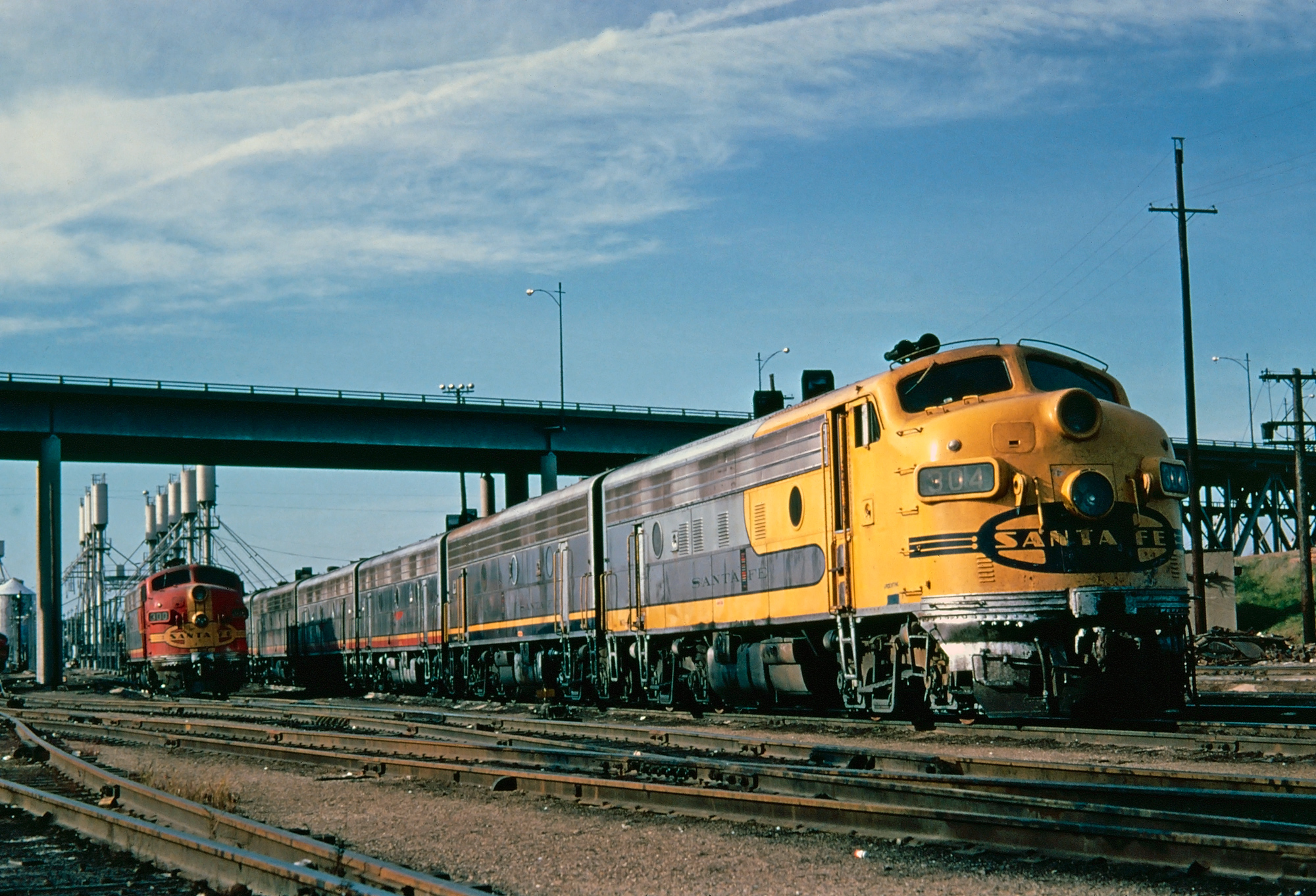 A Santa Fe "Yellowbonnet," F7A #304-L, and other F units layover near the servicing rack at Argentine Yard (Kansas), circa 1973. Also note F7A #300-L in the background. American-Rails.com collection.
A Santa Fe "Yellowbonnet," F7A #304-L, and other F units layover near the servicing rack at Argentine Yard (Kansas), circa 1973. Also note F7A #300-L in the background. American-Rails.com collection.Kansas railroads are also home to a number of railroad museums and tourist lines that you may be interested in visiting when in the state.
They include the Abilene & Smoky Valley Railroad, Ellis Railroad Museum, Great Plains Transportation Museum, Great Overland Station, Liberal Rock Island Depot, Heart of the Heartlands, Midland Railway, and the Santa Fe Depot Foundation.
All in all Kansas has plenty to offer, whether you are a vacationer, railfan, or maybe even a local Jayhawk interested in some sightseeing or something to do!
Recent Articles
-
Nevada ~ Murder Mystery ~ Dinner Train Rides
Jan 22, 26 10:23 AM
Seamlessly blending the romance of train travel with the allure of a theatrical whodunit, these excursions promise suspense, delight, and an unforgettable journey through Nevada’s heart. -
West Virginia ~ Murder Mystery ~ Dinner Train Rides
Jan 22, 26 10:20 AM
For those looking to combine the allure of a train ride with an engaging whodunit, the murder mystery dinner trains offer a uniquely thrilling experience. -
North Carolina's Thomas The Train Rides
Jan 22, 26 10:17 AM
North Carolina is one of the few states home to two different Thomas the Tank Engine events. Learn more about them here! -
Washington's Thomas The Train Rides
Jan 22, 26 10:14 AM
This article will take you on a detailed journey through A Day Out With Thomas events held in Washington, offering insights into what makes this experience extraordinary for families and railroad enth… -
Kentucky "Valentine's" Train Rides
Jan 22, 26 10:12 AM
If you’re looking for a date night that feels a little more cinematic than the usual reservation-and-a-movie routine, Bardstown’s My Old Kentucky Dinner Train delivers the kind of evening you remember… -
North Carolina "Valentine's" Train Rides
Jan 22, 26 10:09 AM
While GSMR is widely known for warm-weather gorge trips and its hugely popular holiday trains, it also offers one of the most charming winter date-night ideas in the Smokies: a Valentine’s Day dinner… -
Pennsylvania "Valentine's" Train Rides
Jan 22, 26 10:01 AM
Tucked amid the rolling farmland of Lancaster County, Pennsylvania, the Strasburg Rail Road stands as one of the most celebrated and successful heritage railroads in North America. -
Tennessee "Valentine's" Train Rides
Jan 22, 26 09:59 AM
If you’re looking for a Valentine’s date night that feels different—equal parts elegant dinner and living-history railroading—the Tennessee Valley Railroad Museum offers just that. -
Kansas ~ Murder Mystery ~ Dinner Train Rides
Jan 21, 26 01:40 PM
Kansas, known for its sprawling wheat fields and rich history, hides a unique gem that promises both intrigue and culinary delight—murder mystery dinner trains. -
Florida ~ Murder Mystery ~ Dinner Train Rides
Jan 21, 26 01:05 PM
Florida, known for its vibrant culture, dazzling beaches, and thrilling theme parks, also offers a unique blend of mystery and fine dining aboard its murder mystery dinner trains. -
New Hampshire ~ Murder Mystery ~ Dinner Train Rides
Jan 21, 26 12:07 PM
The state's murder mystery trains stand out as a captivating blend of theatrical drama, exquisite dining, and scenic rail travel. -
New Jersey Dinner Train Rides In Woodstown
Jan 21, 26 11:20 AM
For visitors who love experiences (not just attractions), Woodstown Central’s dinner-and-dining style trains have become a signature offering—especially for couples’ nights out, small friend groups, a… -
Montana's Dinner Train Rides Near Lewistown!
Jan 21, 26 10:40 AM
The Charlie Russell Chew Choo turns an ordinary rail trip into an evening event: scenery, storytelling, live entertainment, and a hearty dinner served as the train rumbles across trestles and into a t… -
Kansas Valentine's Train Rides
Jan 21, 26 10:09 AM
While the railroad’s regular-season excursions are a big draw, the A&SV also shines with its calendar of themed trains—none more romantic than its Valentine’s Day special. -
Alabama Valentine's Train Rides
Jan 21, 26 09:39 AM
The Heart of Dixie Railroad Museum (HoDRM) is the kind of place where history isn’t parked behind ropes—it moves. This includes Valentine's Day weekend, where the museum hosts a wine pairing special. -
Wisconsin's Dinner Train Rides In North Freedom!
Jan 20, 26 01:55 PM
Featured here is a practical guide to Mid-Continent’s dining train concept—what the experience is like, the kinds of menus the museum has offered, and what to expect when you book. -
New York's Dinner Train Rides In The Adirondacks!
Jan 20, 26 12:41 PM
Operating over a restored segment of the former New York Central’s Adirondack Division, the Adirondack Railroad has steadily rebuilt both track and public interest in passenger rail across the region. -
Pennsylvania "Dinner Train" Rides In Boyertown!
Jan 20, 26 12:04 PM
With beautifully restored vintage equipment, carefully curated menus, and theatrical storytelling woven into each trip, the Colebrookdale Railroad offers far more than a simple meal on rails. -
New York ~ Murder Mystery ~ Dinner Train Rides
Jan 20, 26 12:03 PM
New York State, renowned for its vibrant cities and verdant countryside, offers a plethora of activities for locals and tourists alike, including murder mystery train rides! -
Pennsylvania ~ Murder Mystery ~ Dinner Train Rides
Jan 20, 26 11:48 AM
Pennsylvania, steeped in history and industrial heritage, offers a prime setting for a unique blend of dining and drama: the murder mystery dinner train ride. -
Florida Valentine's Train Rides
Jan 20, 26 11:46 AM
For couples looking for something different this Valentine’s Day, the museum’s signature romantic event is back: the Valentine Limited, returning February 14, 2026—a festive evening built around a tra… -
Connecticut Valentine's Train Rides
Jan 20, 26 11:43 AM
Operated by the Valley Railroad Company, the attraction has been welcoming visitors to the lower Connecticut River Valley for decades, preserving the feel of classic rail travel while packaging it int… -
Texas Dinner Train Rides At The TSR!
Jan 19, 26 12:30 PM
Today, TSR markets itself as a round-trip, four-hour, 25-mile journey between Palestine and Rusk—an easy day trip (or date-night centerpiece) with just the right amount of history baked in. -
Iowa's Dinner Train Rides In Boone!
Jan 19, 26 12:28 PM
If you’ve ever wished you could pair a leisurely rail journey with a proper sit-down meal—white tablecloths, big windows, and countryside rolling by—the Boone & Scenic Valley Railroad & Museum… -
Ohio Dinner Train Rides At The CVSR!
Jan 19, 26 12:27 PM
While the railroad is well known for daytime sightseeing and seasonal events, one of its most memorable offerings is its evening dining program—an experience that blends vintage passenger-car ambience… -
Missouri's Dinner Train Rides In Branson!
Jan 19, 26 12:21 PM
Nestled in the heart of the Ozarks, the Branson Scenic Railway offers one of the most distinctive rail experiences in the Midwest—pairing classic passenger railroading with sweeping mountain scenery a… -
Virginia Valentine's Train Rides
Jan 19, 26 12:15 PM
If you’ve ever wanted to slow life down to the rhythm of jointed rail—coffee in hand, wide windows framing pastureland, forests, and mountain ridges—the Virginia Scenic Railway (VSR) is built for exac… -
Maryland Valentine's Train Rides
Jan 19, 26 12:12 PM
The Western Maryland Scenic Railroad (WMSR) delivers one of the East’s most “complete” heritage-rail experiences: and also offer their popular dinner train during the Valentine's Day weekend. -
Indiana's Dinner Train Rides In Jasper!
Jan 18, 26 01:54 PM
In the rolling hills of southern Indiana, the Spirit of Jasper offers one of those rare attractions that feels equal parts throwback and treat-yourself night out: a classic excursion train paired with… -
New Mexico's Dinner Train Rides
Jan 18, 26 01:37 PM
If your heart is set on clinking glasses while the desert glows at sunset, you can absolutely do that here—just know which operator offers what, and plan accordingly. -
New Hampshire ~ Murder Mystery ~ Dinner Train Rides
Jan 18, 26 01:10 PM
The state's murder mystery trains stand out as a captivating blend of theatrical drama, exquisite dining, and scenic rail travel. -
New York Valentine's Train Rides
Jan 18, 26 12:32 PM
At its best, the Adirondack Railroad delivers exactly what railfans and casual riders alike hope for: vintage coaches, classic depots, rivers and forests right outside the window. -
Washington Valentine's Train Rides
Jan 18, 26 10:50 AM
Whether you’re a dedicated railfan chasing preserved equipment or a couple looking for a memorable night out, CCR&M offers a “small railroad, big experience” vibe—one that shines brightest on its spec… -
Colorado Valentine's Train Rides
Jan 18, 26 10:49 AM
The Royal Gorge Route Railroad is the kind of trip that feels tailor-made for railfans and casual travelers alike, including during Valentine's weekend. -
Georgia Valentine's Train Rides
Jan 18, 26 10:42 AM
f you’ve ridden the SAM Shortline, it’s easy to think of it purely as a modern-day pleasure train—vintage cars, wide South Georgia skies, and a relaxed pace that feels worlds away from interstates and… -
New Jersey ~ Murder Mystery ~ Dinner Train Rides
Jan 17, 26 01:16 PM
There are currently no murder mystery dinner trains available in New Jersey although until 2023 the Cape May Seashore Lines offered this event. Perhaps they will again soon! -
West Virginia Dinner Train Rides In Elkins!
Jan 17, 26 01:08 PM
The D&GV offers the kind of rail experience that feels purpose-built for railfans and casual travelers. -
Virginia Dinner Train Rides In Staunton!
Jan 17, 26 11:55 AM
If you’ve ever wished you could pair a classic scenic train ride with a genuinely satisfying meal—served at your table while the countryside rolls by—the Virginia Scenic Railway was built for you. -
Florida Easter Train Rides
Jan 17, 26 10:23 AM
The cold weather rarely invades Florida and the state nearly always warm and balmy early spring temperatures. Learn more about where you can find Easter-themed train rides across the Sunshine State. -
Ohio Easter Train Rides
Jan 17, 26 10:13 AM
Ohio is home to several museums and excursion trains preserving the state's rich railroading heritage. A few of these locations host Easter-themed train rides each spring. -
Massachusetts Valentine's Train Rides
Jan 17, 26 09:58 AM
The Cape Cod Central Railroad (CCCR) blends classic New England scenery with heritage equipment, narrated sightseeing, and some of the region’s best-known “rails-and-meals” experiences. -
California Valentine's Train Rides
Jan 17, 26 09:53 AM
Operating out of West Sacramento, this excursion railroad has built a calendar that blends scenery with experiences—wine pours, themed parties, dinner-and-entertainment outings, and seasonal specials… -
South Carolina Dinner Train Rides
Jan 16, 26 11:13 PM
There is only location in the Palmetto State offering a true dinner train experience can be found at the South Carolina Railroad Museum. Learn more here. -
Rhode Island Dinner Train Rides
Jan 16, 26 11:01 PM
Despite its small size, Rhode Island is home to one popular dinner train experience where guests can enjoy the breathtaking views of Aquidneck Island. -
Pennsylvania's Thomas The Train Rides
Jan 16, 26 04:13 PM
"A Day Out With Thomas” train rides offer a unique opportunity for children and their families to engage in a magical and memorable experience, setting the stage for a full day of fun and adventure. -
Illinois's Thomas The Train Rides
Jan 16, 26 02:23 PM
In Illinois, the "A Day Out With Thomas" event offers a unique chance for families to immerse themselves in the enchanting world of Thomas and friends, creating memories that last a lifetime. -
New Jersey's Thomas The Train Rides
Jan 16, 26 02:11 PM
Here's a comprehensive guide to what you can expect at Day Out With Thomas events in New Jersey. -
Texas ~ Murder Mystery ~ Dinner Train Rides
Jan 16, 26 01:54 PM
Here’s a comprehensive look into the world of murder mystery dinner trains in Texas. -
Connecticut ~ Murder Mystery ~ Dinner Train Rides
Jan 16, 26 01:26 PM
All aboard the intrigue express! One location in Connecticut typically offers a unique and thrilling experience for both locals and visitors alike, murder mystery trains. -
New Hampshire Dinner Train Rides In N. Conway!
Jan 16, 26 10:47 AM
Tucked into the heart of New Hampshire’s Mount Washington Valley, the Conway Scenic Railroad is one of New England’s most beloved heritage railways

